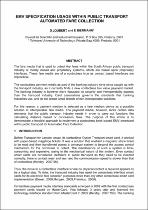JavaScript is disabled for your browser. Some features of this site may not work without it.
- ResearchSpace
- →
- Research Publications/Outputs
- →
- Conference Publications
- →
- View Item
| dc.contributor.author |
Joubert, D

|
|
| dc.contributor.author |
Biermann, E

|
|
| dc.date.accessioned | 2010-09-29T08:42:56Z | |
| dc.date.available | 2010-09-29T08:42:56Z | |
| dc.date.issued | 2010-08 | |
| dc.identifier.citation | Joubert, D and Biermann, E. 2010. EMV specification usage within public transport automated fare collection. 29th Annual Southern African Transport Conference, "Walk Together", CSIR International Convention Centre, Pretoria, South Africa, 16 - 19 August 2010, pp 10 | en |
| dc.identifier.issn | 9781920017477 | |
| dc.identifier.uri | http://repository.up.ac.za/upspace/handle/2263/14886 | |
| dc.identifier.uri | http://hdl.handle.net/10204/4398 | |
| dc.description | 29th Annual Southern African Transport Conference, "Walk Together", CSIR International Convention Centre, Pretoria, South Africa, 16 - 19 August 2010 | en |
| dc.description.abstract | The fare media that is used to collect the fares within the South African public transport industry is mostly closed and proprietary systems, which are based upon proprietary interfaces. These fare media are of a contactless type as contact based interfaces are impractical. The contactless payment media as part of the banking industry have since caught up with the transport industry, as it currently finds a new contactless low value payment market. The banking industry is however more focussed on security and interoperability aspects than the transport industry. Card associations governs the standards that banking industries use, and do not create small islands of non-interoperable solutions. For this reason, a payment medium is selected as a fare medium device as a possible solution to interoperable fare media. The payment media, however, lacks certain data elements that the public transport industry needs in order to carry out functions like calculating distance based or concession fares. The purpose of this article is to demonstrate a feasible approach to implement a contactless bank issued EMV smartcard within public transport for Automated Fare Collection | en |
| dc.language.iso | en | en |
| dc.publisher | Document Transformation Technologies | en |
| dc.subject | Transportation | en |
| dc.subject | Fare media | en |
| dc.subject | Public transport | en |
| dc.subject | Contactles payment media | en |
| dc.subject | Banking industry | en |
| dc.subject | EMV smartcard | en |
| dc.subject | Automated fare collection | en |
| dc.subject | SATC 2010 | en |
| dc.title | EMV specification usage within public transport automated fare collection | en |
| dc.type | Conference Presentation | en |
| dc.identifier.apacitation | Joubert, D., & Biermann, E. (2010). EMV specification usage within public transport automated fare collection. Document Transformation Technologies. http://hdl.handle.net/10204/4398 | en_ZA |
| dc.identifier.chicagocitation | Joubert, D, and E Biermann. "EMV specification usage within public transport automated fare collection." (2010): http://hdl.handle.net/10204/4398 | en_ZA |
| dc.identifier.vancouvercitation | Joubert D, Biermann E, EMV specification usage within public transport automated fare collection; Document Transformation Technologies; 2010. http://hdl.handle.net/10204/4398 . | en_ZA |
| dc.identifier.ris | TY - Conference Presentation AU - Joubert, D AU - Biermann, E AB - The fare media that is used to collect the fares within the South African public transport industry is mostly closed and proprietary systems, which are based upon proprietary interfaces. These fare media are of a contactless type as contact based interfaces are impractical. The contactless payment media as part of the banking industry have since caught up with the transport industry, as it currently finds a new contactless low value payment market. The banking industry is however more focussed on security and interoperability aspects than the transport industry. Card associations governs the standards that banking industries use, and do not create small islands of non-interoperable solutions. For this reason, a payment medium is selected as a fare medium device as a possible solution to interoperable fare media. The payment media, however, lacks certain data elements that the public transport industry needs in order to carry out functions like calculating distance based or concession fares. The purpose of this article is to demonstrate a feasible approach to implement a contactless bank issued EMV smartcard within public transport for Automated Fare Collection DA - 2010-08 DB - ResearchSpace DP - CSIR KW - Transportation KW - Fare media KW - Public transport KW - Contactles payment media KW - Banking industry KW - EMV smartcard KW - Automated fare collection KW - SATC 2010 LK - https://researchspace.csir.co.za PY - 2010 SM - 9781920017477 T1 - EMV specification usage within public transport automated fare collection TI - EMV specification usage within public transport automated fare collection UR - http://hdl.handle.net/10204/4398 ER - | en_ZA |






